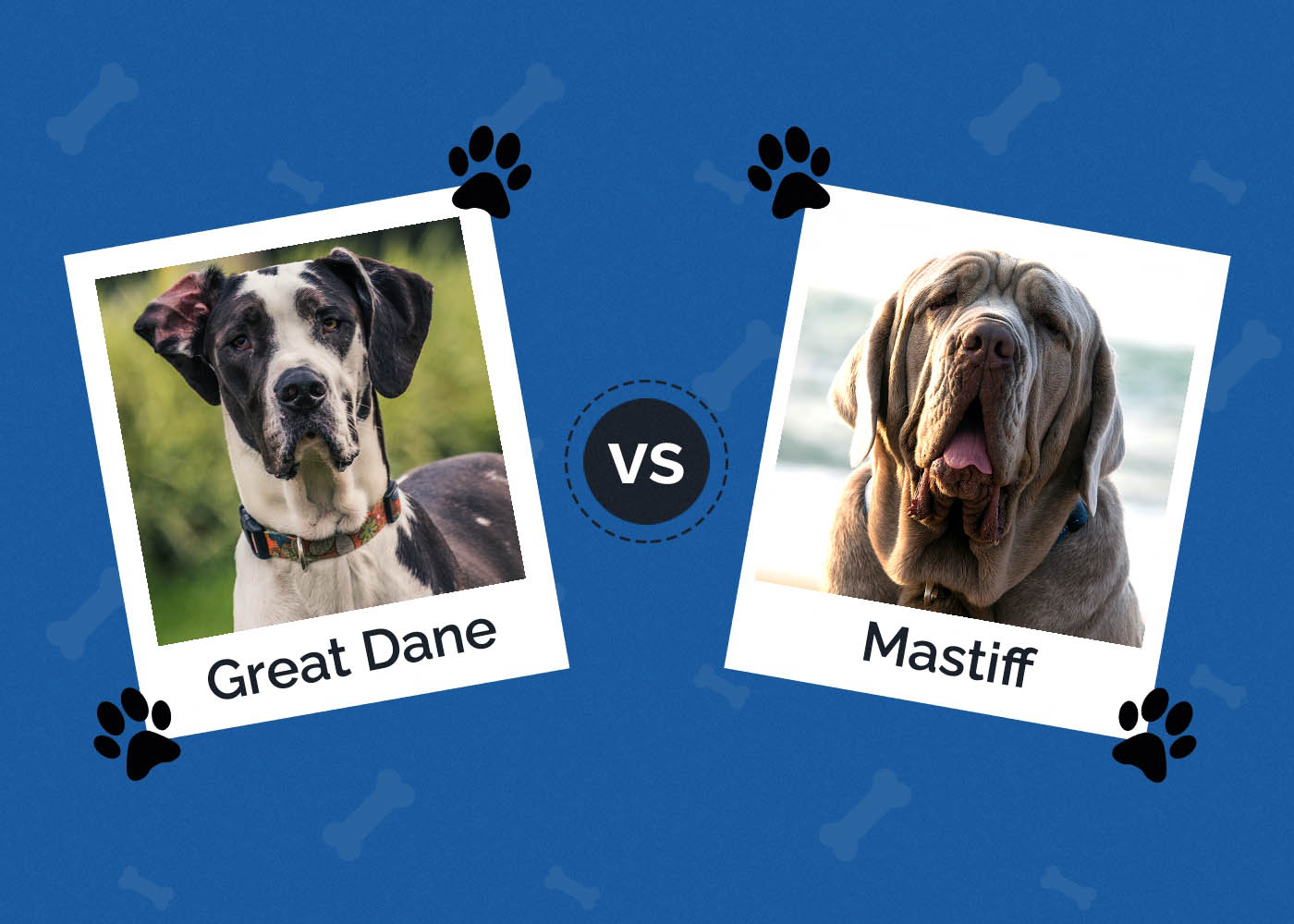Great Dane vs Mastiff: What’s the Difference? (With Pictures)

Updated on

Great Danes and Mastiffs are two incredible breeds, with both breeds breaking world records in size and height. These European-based dogs have been around for a long time, thereby establishing themselves as popular breeds of choice. If you’ve been considering getting a Great Dane or Mastiff, here is a quick guide that may help you decide which breed is right for you.
Visual Differences

A Quick Overview – Great Dane vs Mastiff
The Great Dane and the Mastiff are both huge dogs, and have a lot of other similarities, but they are different breeds, so they also have their sets of unique characteristics. Let’s break it down.
- Average Height (adult): 26–34 inches
- Average Weight (adult): 100–200 pounds
- Lifespan: 7–10 years
- Exercise: 2 hr/day
- Grooming needs: Low and easy
- Family-friendly: Yes
- Dog-friendly: Yes
- Trainability: Easy
- Average Height (adult): 27–32 inches
- Average Weight (adult): 130–220 pounds
- Lifespan: 6–10 years
- Exercise: 1 hr/day
- Grooming needs: Moderate
- Family-friendly: Yes
- Dog-friendly: Sometimes
- Trainability: Moderate
About the Great Dane

History
The history of Great Danes is said to go back as far as 400 years, created by mixing several popular breeds, including the Irish Wolfhound and a few Mastiffs. Great Danes were designed for guarding and hunting but were often found as companions for royals and noblemen. It wasn’t until the late 1880s that the Great Dane became an established breed but went through several name changes before arriving at the name, “Great Dane”.
Appearance
Great Danes are mostly known for their massive height and build, standing at a minimum of 30 to 32 inches and weighing between 120–180 pounds. Great Danes have large, mastiff-like muzzles, naturally floppy ears, and long legs. Their soft coats are short and come in a wide variety of colors and patterns.

Temperament
Great Danes may seem imposing and intimidating, but they’re known as the gentle giants of the dog world. Not only do they make excellent family dogs, but they’re also highly intelligent and relatively easy to train. It’s important that they get daily exercise, but over-exercising this breed can lead to serious health problems.
Lifespan
Unfortunately, Great Danes have notoriously short lifespans due to a laundry list of health issues. From bone growth problems to hip dysplasia, Great Danes rarely make it past 8 years old. While they’re great dogs, their short lifespans can be a deal breaker for dog owners who don’t want to lose a dog so quickly.
- Excellent family dogs
- Great temperament
- Moderate exercise
- Multiple health problems
- Short lifespan
About the Mastiff

History
It’s somewhat tricky to pinpoint exactly when the Mastiff was actually developed, with genetic traces going back to much older (or extinct) breeds. From noble courthouses to quiet farmsteads, many different dog breeds have contributed to what we know as the Mastiff today. Breeding records for the Mastiff weren’t started until around the 19th century, but the breed itself is considered to be much older.
Appearance
Mastiffs have enormous bodies with massive heads and black, wrinkly faces. Their coats are short and have a few color variations, including brindle and fawn. Mastiffs are the largest dogs in terms of actual mass, weighing in excess of 160–200 pounds on average and measuring around 30 inches at the shoulders.

Temperament
Mastiffs are known to be mild-mannered dogs that are perfect for families with children. These dogs are natural nanny dogs that will remain loyal to the families and will naturally guard the property. Mastiffs can develop some stubbornness, so a firm hand and a confident owner are essential to keep these massive canines from taking over the household.
Lifespan
Mastiffs typically have a somewhat normal lifespan for a dog, usually between 6–12 years. Although there are dog breeds that live much longer, their lifespans are longer than most extra-large dogs. Mastiffs have serious health issues, from hip dysplasia to genetic conditions that can shorten their lifespans.
- Natural guarding instincts
- Great with children
- Mild-mannered temperament
- Massive size
- Can become stubborn
Great Dane vs Mastiff – Which One Should I Get?
Great Danes and Mastiffs are both great breeds, so the breed you end up with depends on your lifestyle. Both dogs are great with children, but Mastiffs tend to have a more natural nanny instinct. Mastiffs can be mild-mannered but typically are more stubborn than Great Danes. Finally, lifespan should always be considered, especially if you have children. Great Danes do not live long lives, so you may consider a Mastiff if you have young children. Otherwise, when it comes to the Great Dane vs Mastiff, they both have the potential to be amazing pets and companions.
See also:
- English vs American Mastiff: The Differences (With Pictures)
- St Bernard vs Mastiff: Key Differences & Similarities
Featured Image Credit: (L) Earl Wilkerson, Shutterstock | (R) Michelle Cavanagh, Shutterstock














